YF-19 ADVANCED VARIABLE
FIGHTER PROTOTYPE
BACKGROUND
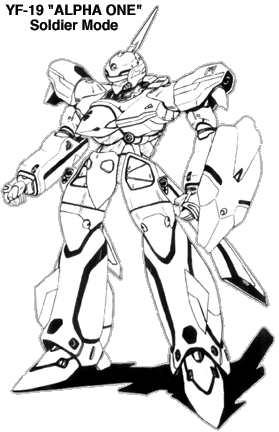 The YF-19 Prototype Advanced Variable Fighter (AVF) was designed
and built in 2039 by Shinsei Industries as their entry into the Project
Super Nova design contest being conducted by the UN Spacy. Project
Super Nova's main purpose was to develop a new variable fighter to replace
the aging VF-11
Thunderbolt as the main fighter for UN Spacy military forces. The YF-19
was one of two fighters selected for the final competition at the New Edwards
Flight Center on planet Eden; the other design being the YF-21
AVF developed by General Galaxy. The YF-19 was developed by Yan
Newmann, the child genius of Shinsei Industries.
The YF-19 Prototype Advanced Variable Fighter (AVF) was designed
and built in 2039 by Shinsei Industries as their entry into the Project
Super Nova design contest being conducted by the UN Spacy. Project
Super Nova's main purpose was to develop a new variable fighter to replace
the aging VF-11
Thunderbolt as the main fighter for UN Spacy military forces. The YF-19
was one of two fighters selected for the final competition at the New Edwards
Flight Center on planet Eden; the other design being the YF-21
AVF developed by General Galaxy. The YF-19 was developed by Yan
Newmann, the child genius of Shinsei Industries.
The YF-19 was plagued with problems and mishaps throughout the course
of the contest. Due to difficulties in controlling such a powerful variable
fighter, the prototype was damaged several times and several test pilots
were killed during the early trials of the aircraft. Eventually Lt.
Isamu Dyson, a talented but reckless UN Spacy pilot, was assigned to
test the YF-19 and quickly proved himself to be a competent pilot for the
prototype. However, during a mock duel between the YF-19 and YF-21, the
YF-19 was damaged by a discharge from its own GU-15 gun pod, almost killing
Lt. Dyson in the process. Shortly thereafter, Project Super Nova was halted
under direct order of the UN Spacy after the development of the Ghost
X-9 Unmanned Fighter in February 2040 was completed. Not satisfied
with the cancellation of the project, Lt. Dyson and Yan Newmann stole the
YF-19 and its fold booster and made an unauthorized fold from Eden to Earth.
The YF-21 prototype was ordered to pursue the YF-19, and the two prototypes
engaged in combat again during the Macross 30th Anniversary Celebration
on Earth. However, the grudge match between the two pilots was interrupted
by the newly completed AI system for pop singer Sharon Apple who
took control of the entire computer system for Earth and attempted to enslave
its entire population through holographic hypnosis. The two prototypes
fought against Sharon and the Ghost X-9 prototype she controlled, and the
YF-19 managed to break through the AI's defenses and destroy her CPU aboard
the SDF Macross.
After the smoke from the incident had settled, the YF-19 was declared
the winner of the Project Super Nova competition. Dubbed the VF-19
Excalibur, the new fighter has begun slowly replacing the VF-11
Thunderbolt as the main tactical superiority fighter for the UN Spacy since
2040. However, it will be several years before the new design comes into
service with all deep space forces and colony missions spread throughout
the galaxy. Several variations of the new design have begun to appear already,
including the VF-19 Kai "Fire Valkyrie" variant aboard the Macross
7, operating near the core of the galaxy. Most of these variants are
one-of-a-kind special operations fighters and are not widely distributed.
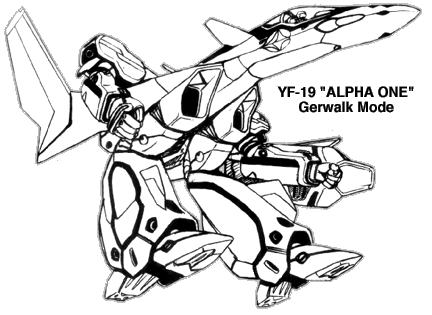
RPG STATS
-
Vehicle Type:
-
YF-19 (Initial Prototype for Project Super Nova, callsign "Alpha One")
-
Class: Advanced Variable Fighter (Prototype)
Manufacturer: Shinsei Industries
Crew: One pilot wearing Tactical Life Support System.
-
A rear seat for a second pilot/navigator can also be added if necessary
for specific missions.
MDC BY LOCATION:
Head Pulse Laser 30
(1) Head 100
Hands (2) 50 each
Arms (2) 110 each
Shoulders (2) 125 each
Legs & Thrusters (2) 220 each
(2) Main Body 375
Canard Forward Wings (2) 30 each
Main Wings (2) 150 each
Tails (2) 50 each
GU-15 Gun Pod 100
Anti-Projectile Shield 150
(3) Pinpoint Barrier Shield 100
Reinforced Pilot Compartment/Escape Pod 150
NOTES:
-
Destroying the head of the YF-19 will knock out the mecha's major sensor
systems, including all of the optics systems (infrared, nightvision, thermal).
Radar and communications will be unaffected.
-
Depleting the MDC of the main body will destroy the mecha. The pilot and
cockpit section/escape pod will be automatically ejected from the doomed
mecha before it explodes by the mecha's main computer.
-
The pinpoint barrier shield regenerates at a rate of 50 MDC per round.
Even if completely destroyed the shield will regenerate within 2 melee
rounds. The shield is usually generated on the right arm of the YF-19.
SPEEDS:
-
RUNNING, SOLDIER CONFIGURATION:
-
120 mph (192 kmph)
-
LEAPING, SOLDIER CONFIGURATION:
-
50 ft (15 m) high or 70 ft (21 m) long without thrusters.
-
FLYING, GERWALK/SOLDIER CONFIGURATION:
-
Mach One (670 mph/1072 kmph) maximum speed limit in an Earth-like atmosphere.
Can also hover in place indefinitely.
-
FLYING, FIGHTER CONFIGURATION:
-
Mach 3.5+ (2345 mph/3572 kmph) max speed at 10,000 meters or less above
sea level. Mach 5.1+ (3417 mph/5205 kmph) max speed at 10,000-30,000 meters
above sea level. Mach 24+ (16,080 mph/24,494 kmph) max speed at 30,000+
meters above sea level, for a maximum of 5 seconds. Cruising speed is usually
Mach 1.8 (1206 mph/1837 kmph). The YF-19 is capable of achieving orbital
velocity over an Earth-class planet without additional rocket assistance.
Maximum rate of ascent is 65,000 meters/minute. Structural G limits are
+31.0 to -18.5 Earth gravities.
-
MAX ENGINE THRUST:
-
42,700 kg x2 in an atmosphere, 67,500 kg x2 in space. The maximum thrust
is automatically limited in an atmosphere due to coolant problems with
the optional air intake systems for the engines.

STATISTICAL DATA:
-
HEIGHT:
-
46.52 ft (14.54 m) in soldier configuration.
-
25.59 ft (8.00 m) in gerwalk configuration.
-
12.60 ft (3.94 m) in fighter configuration.
-
WIDTH:
-
20.80 ft (6.50 m) at shoulders in soldier configuration.
-
47.65 ft (14.89 m) in gerwalk or fighter configuration with wings at maximum
extension.
-
LENGTH:
-
14.29 ft (4.47 m) in soldier configuration.
-
41.69 ft (13.03 m) in gerwalk configuration.
-
59.55 ft (18.62 m) in fighter configuration.
-
WEIGHT:
-
8750 kg empty. Maximum takeoff weight in an atmosphere is 37,509 kg, and
maximum weight in space with optional fold booster is 46,102 kg (weights
beyond that exceed theoretical safe limit for fold booster).
-
PHYSICAL STRENGTH:
-
Equal to a P.S. of 60
-
CARGO:
-
Small compartment behind pilot's seat for personal belongings.
-
POWER PLANT:
-
Two 67,500 kg Shinnakasu Industry/Pratt & Whitney/Rolls Royce FF-2500E
thermonuclear turbine engines, designed for dual atmosphere/space use with
optional concealed air intakes for use in an Earth-type atmosphere. Two
2-dimensional independentent convergent/divergent exhaust are equipped
on the FF-2500E for greater maneuverability and V/STOL performance. In
addition, several Pratt & Whitney HMM-6J high-maneuverability vernier
thrusters are mounted on the wingtips, vertical stabilizers, nose, and
other key locations for added performance. Additional thruster options
include an external fold generator developed for use with Project
Super Nova.
WEAPON SYSTEMS:
-
MAULER REB-30G ANTI-AIRCRAFT PULSE LASER: The YF-19 mounts a single
pulse laser for use in air combat skirmishes and for defensive purposes.
The laser is mounted on the head of the mecha in soldier mode, and is located
in the central dorsal section of the main body pointed rearward in fighter
and gerwalk modes. The laser can only fire to the REAR of the fighter in
these modes; it cannot be turned to fire along another arc.
-
PRIMARY PURPOSE: Anti-aircraft
-
SECONDARY PURPOSE: Anti-missile/defensive
-
RANGE: 4000 feet (1200 m)
-
DAMAGE: 2D4 M.D.
-
RATE OF FIRE: The laser can be fired in rapid pulses up to 4 blasts
per round. A rapid fire blast counts as a burst of up to 4 shots.
-
PAYLOAD: Effectively Unlimited.
-
MAULER REB-23 LASER GUNS: Two semi-fixed laser guns are mounted
in the wings of the YF-19, near the base of the wing where it connects
to the main body. These lasers can be fired in any mode (the beams exit
the hip-mounted wing units in soldier mode) but can only be aimed along
the front arc of the mecha (max angle is about 45 degrees in any direction
from the nose).
-
PRIMARY PURPOSE: Anti-mecha
-
SECONDARY PURPOSE: Air-to-ground strafing runs
-
RANGE: 4000 feet (1200 m)
-
DAMAGE: 1D4 M.D. per laser for a single shot, 1D4x10 M.D. for a
burst (counts as one attack).
-
RATE OF FIRE: Single shots or bursts only. The cannons can be fire-linked
so that firing both cannons at the same time counts as one attack (does
double damage).
-
PAYLOAD: Effectively Unlimited.

-
HOWARD GU-15 EXTERNAL GUN POD: The main weapon of the YF-19 is the
new GU-15 Gun Pod produced by Howard Industries. The gun pod is mounted
on a special hardpoint below the AVF in fighter mode, and is hand-held
in gerwalk and soldier modes. Unlike the gun pods used by the original
VF-1 Valkyrie, the GU-15 uses clips of ammo instead of a self-contained
supply in the barrel of the gun. Two spare clips for the GU-15 are mounted
on the back of the YF-19's bulletproof shield; replacing a clip takes two
melee actions and can only be done in Gerwalk or Soldier mode.
-
PRIMARY PURPOSE: Assault
-
SECONDARY PURPOSE: Anti-mecha
-
RANGE: 4000 feet (1200 m)
-
DAMAGE: Does 4D6 M.D. for a short burst, 1D6x10 M.D. for a long
burst, or 2D6x10 M.D. for a full melee burst.
-
RATE OF FIRE: Equal to the number of combined attacks of the pilot.
-
PAYLOAD: Each clip holds 400 rounds, equal to 40 short bursts, 20
long bursts, or 10 full melee bursts.
-
BODY/WING HARD POINTS: Two fixed hard points are mounted on the
fuselage of the YF-19, and an additional two hardpoints are mounted on
each wing for a total of 6 hardpoints on the fighter. These hardpoints
can be used to hold a variety of different ordinance types, including long,
medium, or short range missiles, or even the new medium-range high-maneuverability
(MRHM) missiles. One long range, one MRHM, 3 medium range, or 5 short
range missiles can be mounted per hardpoint. Usually long range or MRHM
missiles are issued.
NOTE: Due to the location of the hard points, ALL missiles
must be fired or ejected before the YF-19 may convert into soldier mode.
For this reason the hard point missiles are usually fired within the first
few passes of an attack.
-
MEDIUM RANGE HIGH MANEUVERABILITY MISSILES
-
Primary Purpose: Anti-Mecha
-
Secondary Purpose: Surgical Strikes
-
Mega-Damage: 2D6x10 M.D.
-
Rate of Fire: One per hardpoint.
-
Range: 80 miles.
-
Payload: One per hardpoint; 6 maximum.
-
LONG RANGE MISSILES
-
Primary Purpose: Heavy Assault
-
Secondary Purpose: Anti-Spacecraft
-
Missile Types: Any type of standard UN Spacy Long Range Missile
can be used.
-
Range: Varies with missile type.
-
Damage: Varies with missile type.
-
Rate of Fire: One or two.
-
Payload: One per hardpoint; 6 maximum.
-
MEDIUM RANGE MISSILES
-
Primary Purpose: Assault
-
Secondary Purpose: Anti-Mecha
-
Missile Types: Any type of standard UN Spacy Medium Range Missile
can be used.
-
Range: Varies with missile type.
-
Damage: Varies with missile type.
-
Rate of Fire: 1-3 missiles per hardpoint.
-
Payload: Three per hardpoint; up to 18 maximum.
-
SHORT RANGE MISSILES
-
Primary Purpose: Assault
-
Secondary Purpose: Anti-Mecha
-
Missile Types: Any type of standard UN Spacy Short Range Missile
can be used.
-
Range: Varies with missile type.
-
Damage: Varies with missile type.
-
Rate of Fire: 1-5 missiles per hardpoint.
-
Payload: Five per hardpoint; up to 30 maximum.
-
INTERNAL LEG-MOUNTED MISSILE BAYS: Each leg of the YF-19 contains
an enclosed missile bay which can be
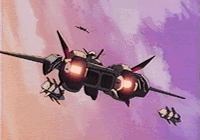 customized for different mission objectives and carry a variety of different
missile types. When armed, the launcher assemblies extend from the sides
of the legs, allowing all missiles to be fired at once if necessary. The
missiles can be fired in any mode. The missile launchers can be equipped
to hold standard SRM missiles, the new Bifors BMM-24 all- environment high-maneuverability
micro-missiles (NOTE: These are NOT the medium-range versions
of the high-maneuverability missiles seen in Macross Plus #1), or
one long-range missile each. In order to carry different types of missiles
the launchers must be refitted at a UN Spacy base prior to loading.
customized for different mission objectives and carry a variety of different
missile types. When armed, the launcher assemblies extend from the sides
of the legs, allowing all missiles to be fired at once if necessary. The
missiles can be fired in any mode. The missile launchers can be equipped
to hold standard SRM missiles, the new Bifors BMM-24 all- environment high-maneuverability
micro-missiles (NOTE: These are NOT the medium-range versions
of the high-maneuverability missiles seen in Macross Plus #1), or
one long-range missile each. In order to carry different types of missiles
the launchers must be refitted at a UN Spacy base prior to loading.
-
SRM/BMM-24 MISSILES
-
Primary Purpose: Assault
-
Range: 5 miles (8 km).
-
Damage: 1D6x10 M.D.
-
Rate of Fire: Volleys of 1-9 missiles per launcher, per round. One
volley counts as one attack. If necessary, all 18 missiles can be fired
in a single round by expending two attacks.
-
Bonuses: The BMM-24 micro-missiles have a +6 to strike and +5 to
dodge, and get 3 attacks per round until they hit or are destroyed.
-
Payload: 9 missiles per launcher; 18 total.
-
LONG RANGE MISSILES
-
Primary Purpose: Heavy Assault
-
Missile Types: Any type of standard UN Spacy Long Range Missile
except Nuclear Multi-Warhead and Nuclear Anti-Warship can be used.
-
Range: Varies with missile type.
-
Damage: Varies with missile type.
-
Rate of Fire: Firing each missile counts as one attack.
-
Payload: 1 missile per launcher; 2 total.
-
HOWARD PBS-03F PIN-POINT BARRIER SYSTEM: The YF-19 is equipped with
a new mecha-scale pinpoint barrier system for defense. The system can generate
a single pinpoint barrier that can be moved anywhere on the mecha and used
as a shield against incoming attacks. The barrier provides 100 MDC of protection,
and regenerates at a rate of 50 MDC per round when damaged. Even if destroyed
by combined attacks, the shield will regenerate itself within 2 rounds.
In order to use the shield, the pilot must make a successful parry roll
to intercept an incoming attack.
-
Primary Purpose: Defense
-
Protection: 100 MDC total
-
Regeneration Rate: 50 MDC per round.
-
Size: The barrier can be up to 10 ft (3 m) in diameter.
-
Duration: Unlimited.
-
HAND TO HAND COMBAT: If necessary, the YF-19 can engage in melee
combat rather than use a weapon. The AVF is extremely agile and can execute
most typical hand to hand combat moves, such as punches, jump kicks, leap
attacks, rolling with impacts, etc.
DAMAGE: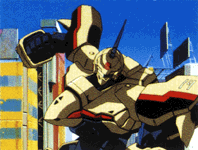
-
Restrained Punch: 1D6 M.D.
-
Full Strength Punch: 3D6 M.D.
-
"Booster" Punch: 4D6 M.D. (counts as two attacks)
-
Tear or Pry with Hands: 2D4 M.D.
-
Kick: 2D4 M.D.
-
Leap Kick: 3D6 M.D.
-
Body Flip/Throw: 1D6 M.D.
-
Body Block/Tackle: 2D6 M.D.
-
Stomp: 2D6 M.D. (only effective against small objects)
STANDARD EQUIPMENT FOR THE YF-19:
-
ACTIVE STEALTH SYSTEM: Although not originally included in the design,
the YF-19 was upgraded to include an active stealth system similar to the
YF-21's during the Project Super Nova trials. Unlike passive stealth systems
like those used by the VF-17 Nightmare or the old USAF F-117, the YF-19's
stealth system is actually bends radar waves around the mecha rather than
reflecting them. The YF-19's stealth system is not quite as good as the
YF-21's due to sacrifices that had to be made in order to fit the system
into the YF-19's fuselage. When activated, this system gives the YF-19
a +3 on initiative (but no bonus to strike) at all times.
NOTE: Since the YF-19's stealth capability is a system and not a
feature of the design, it can be damaged or destroyed. Once the mecha has
lost half of its main body MDC, there is a 50% chance that the stealth
system will fail every time the main body of the craft is hit. Once the
stealth system has failed, it will not work again until repaired at a UN
Spacy base.
-
AUTO-PILOT: The YF-19 is equipped with a computerized auto-pilot,
allowing the pilot to relax or even sleep during long voyages. The auto-
pilot can be programmed with a single destination or a complex flight plan
involving multiple speeds, directions, and destinations. The onboard computer
will alert the pilot when the fighter is near its destination, and can
also be set to automatically signal when sensors detect objects near the
mecha. The auto-pilot was designed with long intra-system space journeys
in mind.
-
COMBAT COMPUTER: The YF-19 is equipped with an advanced AI combat
computer that can store and analyze data during combat with hostile forces.
Data collected by the combat computer can be displayed on the virtual environment
cockpit of the mecha (see below), which allows the system to display large
amounts of data to the pilot and even highlight enemies and missile attacks
with overlaid graphics. The combat computer tracks and identifies specific
enemy targets, and has a database of over 10,000 images stored in memory.
The computer can identify and track up to 250 targets simultaneously.
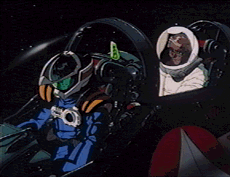
-
COPILOT SEAT: The YF-19 can be equipped with a second pilot's seat
behind the main pilot's seat for an optional copilot, if necessary. The
copilot will usually act as the navigator for the YF-19 and will be responsible
for operating the mecha's fold booster (if equipped). The copilot can assume
command of the YF-19 if the pilot becomes incapacitated.
-
ESCAPE POD: The entire reinforced cockpit of the YF-19 is a detachable
escape pod that can be jettisoned when the mecha is destroyed. The ejected
cockpit does not contain thrusters, but does contain a powerful locator
beacon and an integrated life support system that can support the pilot
for up to 24 hours after ejection. The pod is also equipped with parachutes
in case of ejection in an atmosphere. The combat computer is programmed
to automatically eject the escape pod if the mecha is destroyed (main body
MDC reduced to 0), but this can be overridden if the pilot is feeling suicidal
for some reason.
-
EXTERNAL AUDIO PICKUP: Range: 300 ft (91.5 m). A sound amplification
system that can pick up normal conversation up to 300 feet away.
-
HEAT AND RADIATION SHIELDS: Special shielding prevents the penetration
of life threatening head and radiation. A radiation detection and alarm
system are linked with the shields and will sound an alarm if there is
a rupture in the shields and what the levels of radiation are.
-
HOMING SIGNAL: The escape pod of the YF-19 is equipped with a homing
device that enables rescue teams to locate a disabled craft or ejected
life pod. The range of the signal is 400 miles (640 km). Most UN Spacy
ships and variable fighters can locate and track a homing signal, and the
onboard computers will automatically notify their pilots if such a signal
is detected.
-
LASER TARGETING SYSTEM: Range: 100 miles (160 km). Used for increased
accuracy in the striking of enemy targets and is partly responsible for
the mecha's strike bonus.
-
LOUDSPEAKER: A loudspeaker system is built into the craft, which
can be used to amplify the pilot's voice up to 90 decibels.
-
OPTICS: INFRARED: Range: 2000 feet (610 m). This optical system
projects a beam of infrared light that is invisible to the normal eye,
but detectable by the mecha's sensors. The system allows the pilot to detect
hidden/concealed objects by their IR reflectiveness. The beam will be visible
to anyone with IR sensitive optics, however.
-
OPTICS: NIGHTVISION: Range: 2000 feet (610 m). A passive light image
intensifier that emits no light of its own, but relies on ambient light
which is electronically amplified to produce a visible picture.
-
OPTICS: THERMAL IMAGER: Range: 2000 feet (610 m). A passive optical
heat sensor that detects infrared radiation projected by warm objects and
converts that data into a false-color visible image. The system enables
the pilot to see in the dark, in shadows, and through smoke, and also adds
a +10% bonus to pilots using a tracking skill.
-
RADAR: 200 mile (321 km) range.
-
RADIO/VIDEO COMMUNICATION: Long range, directional communications
system with satellite relay capabilities. Range: 600 miles (960 km) or
can be boosted indefinitely via satellite relay.
-
SELF-DESTRUCT: To prevent capture of an advance variable fighter
by the enemy, the pilot can activate the YF-19's self-destruct system,
which will cause the fighter to explode after a delay of up to 60 minutes
(time is set by the pilot). The explosive damage is contained within a
20 foot (6 m) area and inflicts 1D6x10 M.D. to everything within the radius
of the explosion. All internal systems are obliterated. The escape pod
will be automatically ejected prior to the explosion unless the pilot overrides
the ejection sequence.
-
STANDARD SURVIVAL KIT: All UN Spacy VFs come equipped with a portable
survival kit. Inside the small reinforced box is a medium-sized flashlight,
two hand flares, one rocket flare, a compass, infrared distancing binoculars,
a small mirror, a pocket knife, dehydrated and concentrated food (can be
stretched into a five day supply for one person) and basic first aid items
(aspirin, bandages, disinfectants, etc.)
-
TACTICAL LIFE SUPPORT SYSTEM: The YF-19's cockpit is pressurized,
and also provides additional air feeds to the pilot's flight suit that
provides him with pressurized breathing. The UN Spacy flight suit also
contains an upper and lower g-suit that promotes blood circulation even
during high-g turns, thus decreasing the possibility of pilot's blacking
out in combat.
-
VIRTUAL ENVIRONMENT COCKPIT: The YF-19 is equipped with an innovative
new cockpit layout that provides monitors below and around the pilot in
addition to the HUD cockpit dome. In flight, these monitors display what
is below and behind the aircraft, giving the pilot a tremendous field of
view that is unparalled by any other aircraft (with the possible exception
of the YF-21's
brain-direct imaging system). This wide view in addition to the combat
computer's cockpit overlays give the YF-19 a +1 to dodge and initiative
rolls in addition to any other bonuses.
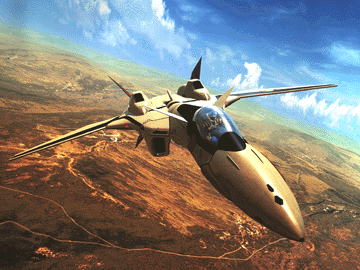
COMBAT BONUSES FOR YF-19 FIGHTER TRAINING:
NOTE: Due to the prototype nature of the YF-19, it is
highly recommended that no player be allowed to start the game with YF-19
combat training (unless the GM is running a post-Macross 7 campaign).
Untrained pilots should get bonuses equal to Basic Variable Fighter
Combat Training when piloting the YF-19, and military pilots with no
prior YF-19 experience should get full bonuses from Advanced VF-11 Thunderbolt
Combat Training. Players should only be allowed to get advanced training
for the YF-19 when their characters have accumulated enough experience
to acquire new skills.
ADVANCED YF-19/VF-19 AVF COMBAT TRAINING
-
Advanced training for pilots specializing in the YF-19/VF-19.
-
4 attacks per melee (plus those of the pilot).
-
Add one additional action/attack at levels two, five, seven, and ten.
-
+2 on initiative (+5 when using Active Stealth System).
-
+3 to strike
-
+4 to parry
-
+4 to dodge in solder mode, +6 in gerwalk, +8 in jet mode.
-
+3 to roll with a punch or fall with an impact, reducing damage by half.
-
+3 to leap dodge. A leap dodge is an automatic dodge which causes no loss
of attacks per melee. The new generation variable fighters are so maneuverable
that the pilot can dodge an attack while moving to counterattack an enemy.
-
Critical strike same as pilot's hand-to-hand.
-
Body block/tackle/ram - 2D4 M.D. plus a 50% chance of knocking an opponent
down, causing him to loose initiative and one attack that melee round.

 The YF-19 Prototype Advanced Variable Fighter (AVF) was designed
and built in 2039 by Shinsei Industries as their entry into the Project
Super Nova design contest being conducted by the UN Spacy. Project
Super Nova's main purpose was to develop a new variable fighter to replace
the aging VF-11
Thunderbolt as the main fighter for UN Spacy military forces. The YF-19
was one of two fighters selected for the final competition at the New Edwards
Flight Center on planet Eden; the other design being the YF-21
AVF developed by General Galaxy. The YF-19 was developed by Yan
Newmann, the child genius of Shinsei Industries.
The YF-19 Prototype Advanced Variable Fighter (AVF) was designed
and built in 2039 by Shinsei Industries as their entry into the Project
Super Nova design contest being conducted by the UN Spacy. Project
Super Nova's main purpose was to develop a new variable fighter to replace
the aging VF-11
Thunderbolt as the main fighter for UN Spacy military forces. The YF-19
was one of two fighters selected for the final competition at the New Edwards
Flight Center on planet Eden; the other design being the YF-21
AVF developed by General Galaxy. The YF-19 was developed by Yan
Newmann, the child genius of Shinsei Industries.



 customized for different mission objectives and carry a variety of different
missile types. When armed, the launcher assemblies extend from the sides
of the legs, allowing all missiles to be fired at once if necessary. The
missiles can be fired in any mode. The missile launchers can be equipped
to hold standard SRM missiles, the new Bifors BMM-24 all- environment high-maneuverability
micro-missiles (NOTE: These are NOT the medium-range versions
of the high-maneuverability missiles seen in Macross Plus #1), or
one long-range missile each. In order to carry different types of missiles
the launchers must be refitted at a UN Spacy base prior to loading.
customized for different mission objectives and carry a variety of different
missile types. When armed, the launcher assemblies extend from the sides
of the legs, allowing all missiles to be fired at once if necessary. The
missiles can be fired in any mode. The missile launchers can be equipped
to hold standard SRM missiles, the new Bifors BMM-24 all- environment high-maneuverability
micro-missiles (NOTE: These are NOT the medium-range versions
of the high-maneuverability missiles seen in Macross Plus #1), or
one long-range missile each. In order to carry different types of missiles
the launchers must be refitted at a UN Spacy base prior to loading.

